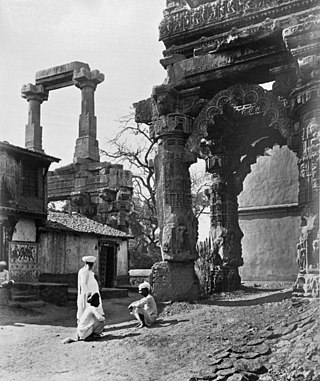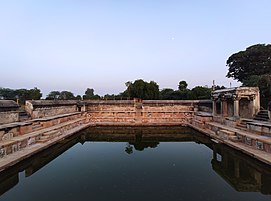
A torana is a free-standing ornamental or arched gateway for ceremonial purposes in Hindu, Buddhist and Jain architecture of the Indian subcontinent. Toranas can also be widely seen in Southeast Asia and parts of East Asia. Chinese Shanmen gateways, Japanese torii gateways, Korean Iljumun and Hongsalmun gateways, Vietnamese Tam quan gateways, and Thai Sao Ching Cha were derived from the Indian torana. They are also referred to as vandanamalikas.

Bahuchara Mata is a Hindu goddess of chastity and fertility in her maiden aspect, of the incarnation of the Hinglaj. The goddess grants favours, especially to male children, and cures diseases. Like other divinities in Gujarat and Rajasthan, Bahuchara is of Charan an origin. She is also considered the patroness of the hijra community. Her primary temple is located in Becharaji town in Mehsana district of Gujarat, India.

Mehsana, also spelled Mahesana, is a city and the headquarters of Mehsana district in the Indian state of Gujarat. Established in 14th century, the city was under Gaekwads of Baroda State from 18th century to the independence of India in 1947. Dairy, oil and natural gas are major industries in the city.

Palanpur is a city and a headquarters of Banaskantha district in the Indian state of Gujarat. Palanpur is the ancestral home to an industry of Indian diamond merchants.

Mehsana district is one of the 33 districts of Gujarat state in western India. Mehsana city is the administrative headquarters of this district. The district has a population of over 1.8 million and an area of over 4,500 km2. There are over 600 villages in this district with a population of 2,035,064 of which 22.40% were urban as of 2011.

The Sun Temple of Modhera is a Hindu temple dedicated to the solar deity Surya located at Modhera village of Mehsana district, Gujarat, India. It is situated on the bank of the river Pushpavati. It was built after 1026-27 CE during the reign of Bhima I of the Chaulukya dynasty. No worship is offered now and it is a protected monument maintained by the Archaeological Survey of India. The temple complex has three components: Gūḍhamanḍapa, the shrine hall; Sabhamanḍapa, the assembly hall and Kunḍa, the reservoir. The halls have intricately carved exterior and pillars. The reservoir has steps to reach the bottom and numerous small shrines.

Taranga is a Jain pilgrimage center near Kheralu in Mehsana district, Gujarat, India, with two compounds of Jain temples that are important examples of the Māru-Gurjara style of architecture. The Ajitnatha temple, was constructed in 1161 by the Chaulukya king Kumarapala, under the advice of his teacher, Acharya Hemachandra. Both the main sects of Jainism are represented, with adjoining walled compounds: the Śvetāmbara compound consists of 14 temples in all, and there are also five Digambara-affiliated temples at Taranga hill.
Karna I was the ruler of the Kingdom of Gujarat. He was a member of the Chaulukya dynasty and ruled from his capital Anahilapataka.

Kirti Stambha is a 12th-century tower situated at Chittor Fort in Chittorgarh town of Rajasthan, India.
Anarta was an ancient Indian region which corresponded to the present-day North Saurashtra to North Gujarat regions in Gujarat state of India. Several ancient inscriptions and literary sources mention a town called Anartapura or Anandapura, which is identified as the area in and around the present-day Vadnagar.

Becharaji or Bahucharaji is a Hindu temple town and taluka capital in Mehsana district of Gujarat state, India. The temple of Hindu goddess Bahuchara Mata in the town is major pilgrimage centre.
Bhima I was a Chaulukya king who ruled parts of present-day Gujarat, India. The early years of his reign saw an invasion from the Ghaznavid ruler Mahmud, who sacked the Somnath temple. Bhima left his capital and took shelter in Kanthkot during this invasion, but after Mahmud's departure, he recovered his power and retained his ancestral territories. He crushed a rebellion by his vassals at Arbuda, and unsuccessfully tried to invade the Naddula Chahamana kingdom. Towards the end of his reign, he formed an alliance with the Kalachuri king Lakshmi-Karna, and played an important role in the downfall of the Paramara king Bhoja.

The Chaulukya dynasty, also Solanki dynasty, was a dynasty that ruled the Kingdom of Gujarat in western India, between c. 940 CE and c. 1244 CE. Their capital was located at Anahilavada. At times, their rule extended to the Malwa region in present-day Madhya Pradesh. The family is also known as the "Solanki dynasty" in the vernacular literature. They belonged to the Solanki clan of Rajputs.
Jayasiṃha, who assumed the title Siddharāja, ruled the Kingdom of Gujarat between 1092 and 1142. He was a member of the Chaulukya dynasty.
Mularaja was the king of Gujarat and the founder of the Chaulukya dynasty. Also known as the Chaulukyas of Gujarat or Solanki, this dynasty ruled parts of present-day Gujarat. Mularaja supplanted the last Chavda king, and founded an independent kingdom with his capital in Anahilapataka in 940-941 CE.

The Rudra Mahalaya Temple, also known as Rudramal, is a destroyed/desecrated Hindu temple complex at Siddhpur in the Patan district of Gujarat, India. Its construction was started in 943 CE by Mularaja and completed in 1140 CE by Jayasimha Siddharaja, a ruler of the Chaulukya dynasty. The Hindu temple was destroyed by the Sultan of Delhi, Alauddin Khalji, and later the Sultan of Gujarat, Ahmed Shah I (1410–1444) desecrated and substantially demolished the temple, and also converted part of it into the congregational mosque of the city. Two torans (porches) and four pillars of the former central structure still stand along with the western part of the complex used as a congregational mosque.

Jasmalnathji Mahadev Temple is a Hindu temple located at Asoda village in Vijapur Taluka, Mehsana district, Gujarat, India. It is locally known as Vaijnath Mahadev temple. The temple is dedicated to Shiva. The temple is built in the 12th century. It consists of a sanctum; mandapa and torana, a porch.
Chamundaraja was an Indian king who ruled parts of present-day Gujarat from his capital at Anahilapataka. He was a member of the Chaulukya dynasty.
Vadnagar archaeological site is located in Vadnagar in Gujarat, India; it is known for its significant findings of a continuing settlement since ancient or pre-Mauryan times.
Modheshwari Mata Temple is an ancient Hindu temple located in Modhera village of Mehsana district in Gujarat, India. The temple is dedicated to the Hindu mother-goddess Modheshwari Mata, an aspect of the divine feminine Shakti. It was built around 1026-1027 CE during the reign of the Solanki dynasty king Bhima I.























